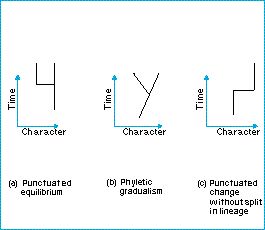Rates of evolution - What is phyletic gradualism?

Speciation events
The key difference between the theories of phyletic gradualism and punctuated equilibrium concerns the relative rates of evolution during, and between, speciation events.
Under phyletic gradualism, evolution has a similar range of rates at the two times; under punctuated equilibrium, it is much faster at the time of splits.
Phyletic gradualism therefore differs from punctuated equilibrium in that it predicts evolutionary change between, as well as during, speciation events.
A further possibility is that evolution might occur in a rapid burst, but without a split in the lineage; this is not accommodated in either of Eldredge and Gould’s alternatives, but it contradicts their view that all change is concentrated into the times of origin of new species.
Figure: the crucial difference between punctuated equilibrium and phyletic gradualism concerns the rate of evolution at, and between, splitting events. (a) punctuated equilibrium; (b) phyletic gradualism. On a strict interpretation of punctuated equilibrium, sudden change without splitting (c) contradicts the theory.
| Next |



